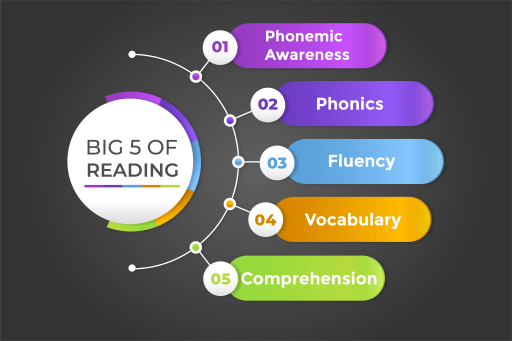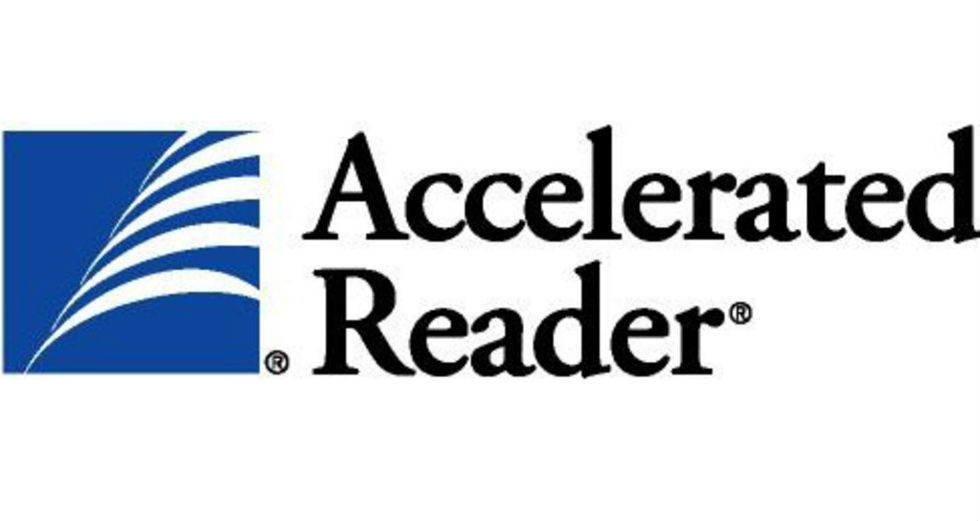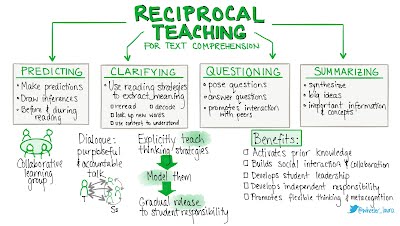Reading
We see reading as the key to unlocking all other areas of learning, and therefore urge parents and carers to enjoy spending time reading with and to their child every single day.
At Longford Park, Miss Hathway is our reading lead.
The Big 5 of Reading.
Teaching reading runs throughout a child’s entire school life. The Big 5 are evidence based components of reading which all need to be taught, practised and embedded for children to be successful, confident readers.

Phonics
Phonics is the understanding that there is a predictable relationship between phonemes (individual sounds of spoken language) and graphemes (letters of written language).
Phoneme Awareness
This refers to the ability to hear, identify, and manipulate individual sounds, or phonemes, in spoken words. Phonemic awareness is important because it improves children’s word reading and reading comprehension. It also helps them learn to spell.
Vocabulary
Vocabulary refers to the words we must know to communicate effectively. Oral vocabulary describes words we use in speaking or recognise in listening, while reading vocabulary refers to words we recognise or use in print.
Fluency
Fluency refers to the ability to read a text accurately and quickly. Fluent readers are able to focus their attention on comprehension (i.e., making connections between the ideas in a text and their background knowledge), while less fluent readers are focused on decoding individual words and have little attention left for comprehending the text.
Text Comprehension
Text comprehension is the goal of reading, and thus children must be able to move beyond reading individual words in order to comprehend texts.
Phonics and Phonemic Awareness
Phonics is taught using the letters and sounds sequence of teaching. This begins in EYFS and is completed for the majority of children in Year 2. Some children may need more support with phonics. It is important to go back to phonics for those that need it, otherwise they will continue to struggle with reading due to these early gaps. It is important that all staff are confident and knowledgeable about phonics as it provides the basis for reading and for spelling.
Teaching and Learning of Reading.
We teach to the National Curriculum English programmes of study for KS1 and KS2.
1:1 Reading
1:1 Reading is important for all children. It is a time when phonics and fluency can be developed, comprehension assessed and individual problems tackled. The teacher should hear all children read and extra support can be provided by TAs, volunteers and parents. Time to hear children read is provided in the reading for pleasure cycle. The fluency matrix should be used to support feedback, modelling and development.
Assessing Reading
Reading can be assessed in many different ways. Formative assessment can be done through:
- Listening to children read
- Asking them questions
- Having a group discussion
- Using the fluency matrix
- Accelerated reader quizzes
Summative assessment is done through:
- Salford Reading Test (Reading Age)
- STAR Reader (Reading Age and Diagnostic)
- SATs Reading Tests (Year 2 and 6)
- Phonics Screening Check (Year 1)
However, these assessments should not be used in isolation to form a judgement of a child’s reading. All aspects and forms of evidence should be taken into account in order to build a picture and assess against the year group expectations for reading. Moderation of reading will take all of these aspects into account.
Reciprocal Reading
Reciprocal Reading is a structured approach to teaching strategies (questioning, clarifying, summarising and predicting) that students can use to improve their reading comprehension. Initially, students develop their use of these strategies by observing a teacher ‘thinking aloud’. This is followed by opportunities for students to work in groups so that they can continue to observe others using the strategies and experiment with the strategies whilst receiving feedback. Ultimately, the aim is for students to use the strategies with increasing independence. This strategy is used for whole class reading and also as part of the guided reading cycle. Teachers may guide children through each aspect or children may take on the roles themselves.
Non-Fiction Texts
It is important that children read both fiction and non-fiction texts. Balance the use of PowerPoints with reading of articles, reports and books that can be used to support learning. Support will be needed for children to interact with these texts as required e.g. understanding chronology.
Guided Reading and Reading for Pleasure Cycles
All schools will have a guided reading cycle which the children work through, as a group, throughout the week. Within this cycle there will be a taught session with the teacher and a chance for the children to tackle comprehension questions independently. In a Reading for Pleasure cycle there is time assigned for the teacher to hear each child read and give them feedback on their fluency, time for children to read silently, cross curricular reading for a purpose and book related tasks which promote the love of reading. Some cycles may run over a week, others may run over 2 weeks – ensuring all children have access to all activities over the time period.
Accelerated Reader
 Accelerated Reader (AR) is an online system used for children once they are able to test on STAR – usually within Year 2. This is a system to promote reading for pleasure. On STAR children receive a ZPD which indicates what level of book they should be reading (a band e.g. 2.4 – 3.5). Library books are labelled with these levels so that children can be guided to the texts to choose. Once they have read the text children complete an online quiz. They can use the book to help them with this. These quizzes are not tests – children should use the book to support them with these. Reports on quizzes and any other STAR or Early Literacy Test can be viewed by logging into Renaissance Learning.
Accelerated Reader (AR) is an online system used for children once they are able to test on STAR – usually within Year 2. This is a system to promote reading for pleasure. On STAR children receive a ZPD which indicates what level of book they should be reading (a band e.g. 2.4 – 3.5). Library books are labelled with these levels so that children can be guided to the texts to choose. Once they have read the text children complete an online quiz. They can use the book to help them with this. These quizzes are not tests – children should use the book to support them with these. Reports on quizzes and any other STAR or Early Literacy Test can be viewed by logging into Renaissance Learning.






